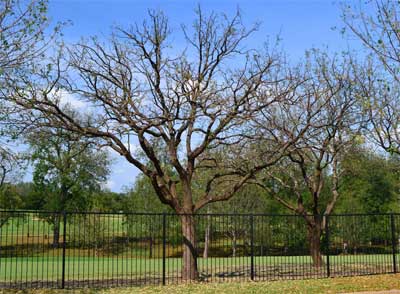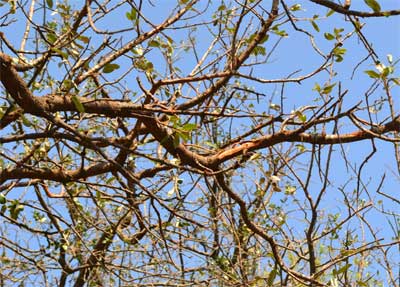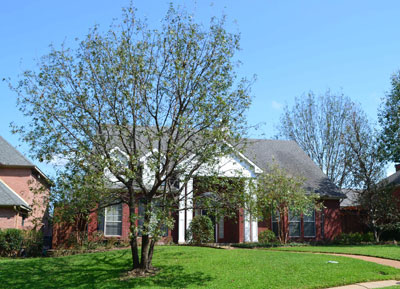Texas Tree Tips – June, 2012

While stripped of foliage, battered and bruised, these hail-damaged live oaks may be salvageable with proper care. Photos courtesy of Bill Seaman.
Hail-Damaged Trees
What to expect after the storm
After the hailstones melt, the broken glass is replaced, and the rooftops are made water tight, gardeners look at their half-naked trees and the torn leaves littering the lawn and wonder, “What do I do for my trees?” Every year, and particularly in late spring and summer, those sought-after thunderheads bring us much-needed rain. Occasionally, accompanying that moisture is damaging hail.

Severe hail can strip soft bark tissue from branches, creating wounds that can be open courts for insects and diseases.
Large hailstones can be devastating to trees. They can strip the finest foliage, snap twigs, and tear tender tissues. Add wind to the formula and they can strip a tree of its bark. Fortunately, healthy trees have a remarkable resilience and have within them the ability to recover from such an event.
A healthy hail-damaged tree that has lost less than 20 percent of its foliage is likely to respond in the way it responds to a light pruning. Damaged leaves that are no longer an asset for the tree’s general health are discarded and replaced with a flush of new growth. Injured stems form callus-like tissues that isolate and cover damaged vascular cells. Recovery from a minor hail event requires no more stored energy reserves than what is required to recover from a late frost.

Healthy young trees are amazingly resilient and can quickly recover from minor hail damage.
When a tree has lost 50 percent or more of its foliage as a result of hail, the response can be more dynamic. Although a healthy tree will likely survive, interior limbs accustomed to being shaded are now exposed to much higher levels of sunlight. The tree reacts to the change by producing interior sprouts. The sprouts are often referred to as “suckers,” but the proper name for them is epicormic sprouts. While not particularly attractive, the sprouts serve an important purpose. In trees that lack a more protective corky bark on smaller limbs (e.g., red oaks and maples), the sprouts provide a quick shade that protects smooth, tender bark from the sun-scalding rays of the summer sun. They also act as an emergency generator, converting that same sunlight into food-making energy. It is very important to leave the sprouts intact until the tree has regained its full canopy, a process that may take several years.
Trees that sustain this level of leaf loss often have significant damage to stems and small branches. Rather than looking up into the canopy of the tree, it may be easier to determine the severity of damage by noting the number of broken stems mixed in with the leaf litter. Extensive wounding of bark tissues requires higher levels of reserved energy to heal. It may require several years for callus tissue to close the wounds, leaving open courts for insects like borers in the short term. In addition to increasing the frequency of fertilization applications until the tree regains its canopy, watch for subsequent insect or pathogen problems. If you are in doubt, ask a qualified arborist to check it out.
In rare cases, hail can strip trees of virtually all their foliage. A kneejerk response may be to remove the tree and start over. However, that might be the wrong approach unless the tree was very unhealthy to begin with, or unless it had other significant problems. Remember that the hail did not damage a significant part of the tree. That part is the root system. A healthy tree’s roots store much of its energy reserves. While a tree may have no foliage and while much of the vascular tissue in the branches and limbs is damaged, the root system, trunk, and structural limbs remain. Dormant buds are future leaves that can sprout in weeks. With the right coaxing and care, it may be possible to return a hail-damaged mature tree into a healthy state much quicker than establishing a replacement tree. It is a time to rely on a gardener’s best, yet often elusive, asset … patience. Within a few months, a hail-damaged tree will reveal its mettle.
About the author: Steve Houser is a Dallas native with more than 30 years of experience as a consulting arborist and tree climber. He is the president of Arborilogical Services Inc., “The Experts Your Trees Deserve.” www.arborilogical.com.

